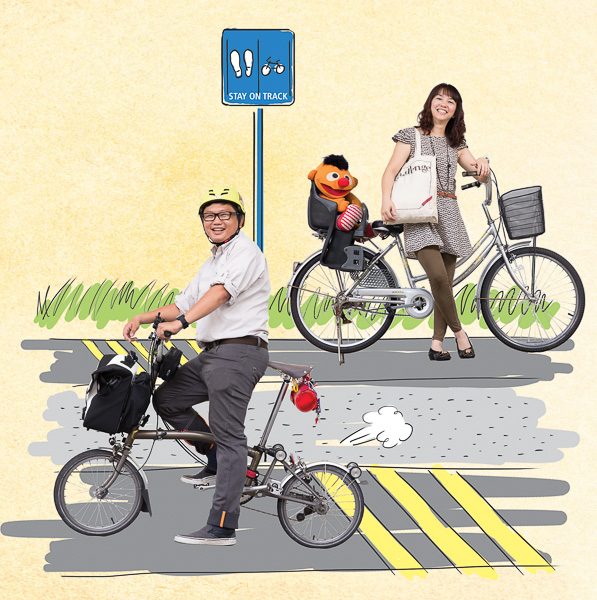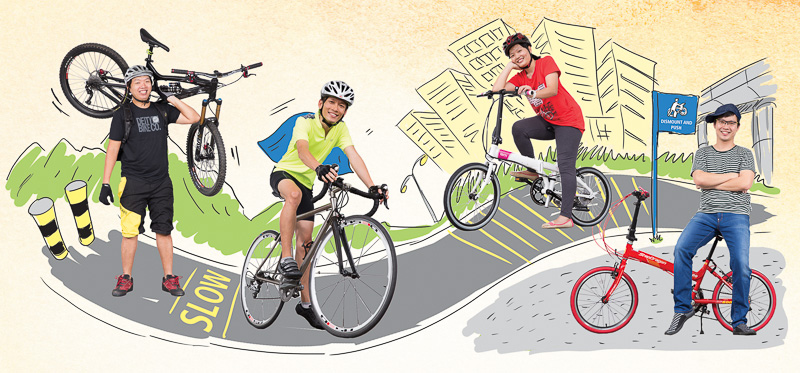Making Singapore a Cycle-Friendly City

Imagine a cyclist ringing his bell loudly as he pedals down a pavement. He feels he’s doing a public service by warning people to get out of the way. To a pedestrian, however, this could be alarming and unwelcome.
The cyclist is neither confident nor skilled enough to go on the roads where motor vehicles rule. But pedestrians, who want to feel safe on sidewalks, are irked by the presence of bicycles.
A cycling development team at the Land Transport Authority (LTA) is trying to resolve this daily grapple for safe spaces.
Set up in 2010 with just four staff, it has, in the recent year, added seven more members, to plan, design and implement infrastructure to facilitate cycling within short distances, such as from home to the supermarket or MRT station, in 23 towns in Singapore.
Their work contributes towards the bigger vision of a Singapore that encourages cycling through a cyclist-friendly, safe and well-connected network.
Team leader Teo Kwang Liak, who is Manager (Traffic Analysis & Planning), says they now see more people who prefer to cycle – instead of walk – short distances.
But unlike sports cyclists or serious hobbyists, many such commuter cyclists look at road traffic and decide they are safer on footpaths. In fact, Mr Teo refers to them as “pedestrians on wheels” – cyclists who forget they are on bicycles and think like pedestrians.
It’s a good thing then that the LTA team includes fervent cyclists (with impressive bicycle collections), weekend recreational cyclists, and a few who hardly cycle. They tap their different perspectives and experiences to look out for the interests of both cyclists and pedestrians.
Their work is an exercise in empathy. Mr Teo lets on that a few members, who used to view cyclists on footpaths as hindrances, are now more understanding towards this group of commuter cyclists.
The team leader himself cycles to work daily from his home in Redhill to his Hampshire Road office. When he began using a foldable bicycle (a “foldie”), he became more empathetic towards wheelchair users. “I had to fold my bicycle, wheel it around, and realised that in certain places like shopping malls, I didn’t know how to get up and down without hurting myself. So whenever we design, we also want to take care of all these people [wheelchair users], as much as we can.”


Learning from others
In the course of their work, the team has met myriad stakeholders, every one of whom has different ideas of what a cycling path should be. Advocates for road cycling lanes, for instance, often point to overseas examples of cycling lanes on roads. However, LTA believes that Singapore’s high urban and vehicular density means protecting cyclists is not as simple as “just painting a line”.
“We realise that we’re not Mr Know- It-All,” says Mr Teo. “We visit… overseas places or ask our colleagues and bosses (when they go on official trips) to look out for issues [that cities with cycling lanes] have.” These include illegal parking on cycling lanes, cars veering too close, and careless cyclists who see cycling lanes as a safe sanctuary.
Even when they are on vacation abroad, the team members keep an eye out for the cycling facilities there. For exam- ple, Mr Teo notes, the Europeans are at ease without helmets, but not with smallwheel bicycles. The latter is because many parts of Europe have cobblestone streets. In contrast, North America has wider paved roads, and many Americans would never dare to ride without helmets.
Working in tandem
The LTA team also works closely with other government agencies when building cycling infrastructure. At the time of this interview, the team was figuring out how cycling paths could be built around some mature trees in Taman Jurong, which the National Parks Board (NParks) wanted to protect. Coincidentally, PUB, the national water agency, has longer term plans to cover large open drains in the same area with concrete slabs.
“We’re working to see whether we can use the space created by PUB … for our cycling paths. This is taking longer than we initially planned, but we figure this is needed because trees don’t happen overnight,” says Mr Teo. “At the same time, slab-over drains also don’t happen overnight.”
LTA is also working closely with NParks to bridge some gaps in its 200-kilometre Park Connector Network, where cycling paths are interrupted by roads or expressways. This includes building wheel ramps to help cyclists push their bicycles across overhead bridges.
Meet the people
Though many in the cycling team have their own bicycles, much of their planning and design work requires walking. The slower pace allows them to capture the details of potential cycling path sites. They measure widths for cycling paths and take photos to record their observations.
But occasionally, the team does hop onto their bicycles, together with officers from partner agencies, to check out common locations and facilities. Sometimes, curious members of the public come up to share suggestions, or just chat.
“We have our gadgets to take measurements, so [members of] the public might ask what we’re doing,” says Senior Executive Engineer Matthew Cheah, who carries out public outreach efforts whenever cycling paths are ready in cycling towns. He adds that it can be “tricky” carrying out engagement work while walking the ground. “They [the public] might ask for a lot of things not within LTA’s scope.”
However, the team has made slight modifications to paths after hearing from such earnest Singaporeans. Small changes such as marking out sharp corners more clearly or shifting paths by a few centimetres can be accommodated.
When the cycling paths in a town are finally ready, the team works with residents, grassroots representatives, schools and the police to promote safe and considerate cycling.
The team knows that having cycling paths does not mean all space conflicts will be resolved.
“We tell pedestrians not to stray into the cycling paths… but the guy on the bicycle is the one ‘driving a vehicle’,” says Mr Teo. “The onus should be on the cy- clist to take more care.”
Who Does What When it Comes to Cycling?
LTA, NParks, the Housing & Development Board, the Urban Redevelopment Authority and the Singapore Sports Council are working together to make the National Cycling Plan a reality; its implementation is overseen by the CEOs of these agencies who sit on the National Cycling Plan Steering Committee.
- POSTED ON
Mar 7, 2014
- TEXT BY
Siti Maziah Masramli









